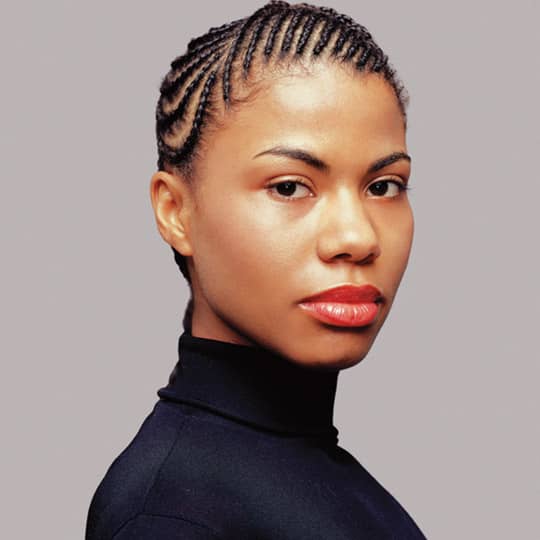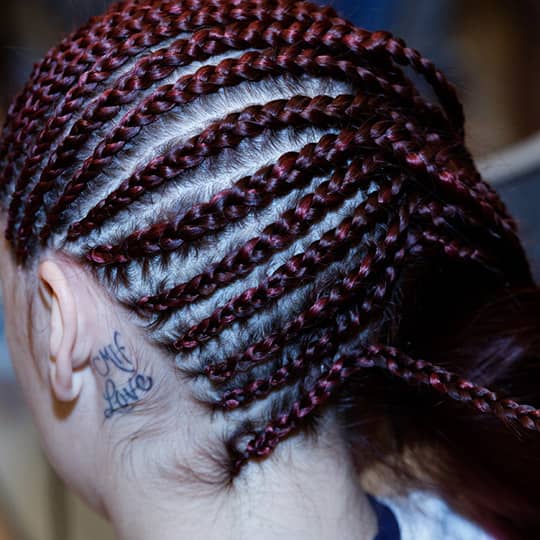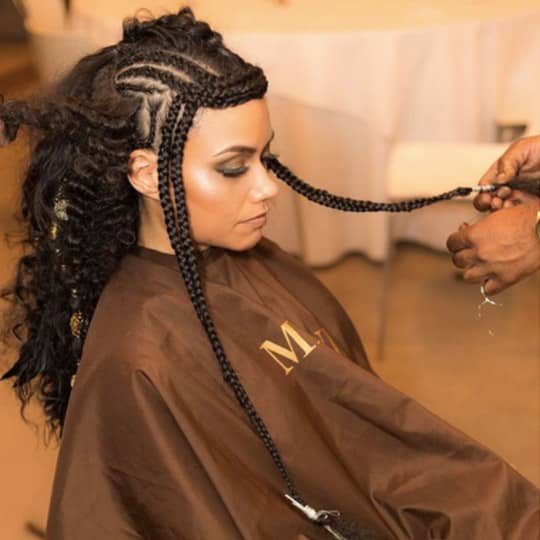Which Hair to Use for Feed in Cornrows
Cornrows may be one of the most coveted hairstyles of 2018, but it is anything but new. Cornrows have been around for centuries in some form or another. How has it maintained such staying power? When you're as chic, versatile, and long-lasting as cornrows—it's not a difficult feat to pull off.
While many people have admired cornrows from afar, some have never attempted to pull off the style themselves. If you love cornrows but just aren't sure where to begin, we've got you covered. We're breaking down everything you need to know about creating and caring for natural hair cornrows.
How To Craft A Cornrow
If you know how to make a traditional three-strand braid, you'll be able to cornrow with ease—it just takes practice.
Before you begin braiding it is important to start with clean, dry, and detangled hair. Combing all of the tangles out of your hair will make sure your strands are less likely to knot up while being braided. After detangling your hair, it is time to part your hair into your desired design. Because cornrows are such a basic style, the versatility comes in how and where you place the braids on your hair.
If you want to cornrow your hair straight back, simply part your hair in rows of your desired thickness. If you're going for a more intricate design, map out where you'll part your design before you begin to braid. Lastly, you want to ensure your natural hair is properly conditioned before you braid it. We recommend spritzing your strands with a moisturizing product like Mizani's 25 Miracle Milk Leave-In.
Work with one section at a time to craft your braid. Start near your hairline and separate the section into three small segments. To begin forming your cornrow start with the classic braid technique, pass the right strand under the middle strand before passing the left strand under the middle strand. It is important to pass the strands under the middle section—this is what separates a cornrow from a French braid.
As you continue to braid, keep the cornrow close to the scalp and begin to merge hair from the rest of the section into the braid as you go. Continue braiding, alternating the left and right segments under the middle segment and adding hair to each segment as you go until you reach the nape of your neck.
If your hair is long enough to hang down your neck and back, switch to the standard braid technique until you reach the end of your braid and secure it with a small hair elastic. Continue braiding until you've cornrowed your entire head.
Caring For Cornrows
Before you go ahead and cornrow your hair, it's important to understand how to care for them properly. Knowing how to care for your braids is not only key to making sure they look flawless, but also crucial to the health of your hair.
The number one mistake people make when getting braids is having their hair braided too tightly. Any style that is too pulled too tight puts you at risk of developing traction alopecia, a form of hair loss primarily caused by pulling the hair. The pulling is often caused by tight styles such as braids and ponytails.
Regularly styling your hair in ways that require pulling can cause scarring—and potentially permanent hair loss. If you feel like your hair is being pulled too tightly, don't hesitate to speak up. No style is worth potentially damaging your precious locks.
Braids can often last several weeks with proper care. Just because you're wearing one hairstyle for weeks doesn't mean you can slack off on your hair care routine, however. Your hair and scalp need just as much attention as they do when your hair isn't braided.
No matter your hair type or texture, we don't recommend going more than a week without washing your hair. If you're keeping braids in for more than a week at a time, you'll need to wash your hair while it remains braided. Shampoo your hair as you normally would, making sure to be gentle and avoid disturbing your style too much. Follow up your shampoo with a hydrating conditioner to make sure your hair looks and feels moisturized.
Once you've washed and conditioned your hair, make sure your strands are completely dry before heading out the door. If you've added extra hair to your 'do, you may want to use a blow dryer or hooded dryer to ensure all of your hair is completely dry. Leaving your hair even a little bit damp (particularly near the scalp) leaves you at risk of developing dandruff, fungus, or even mildew.
If you don't have time to wash and condition your hair regularly, invest in a good astringent—we recommend witch hazel. It will remove dirt and buildup, keeping your scalp healthy between washes. Apply the astringent with cotton swabs to ensure you clean every nook and cranny of your scalp.
Sleeping With Cornrows
Now that you know how to create and care for cornrows, we're sure there's just one more question on your mind: How are you supposed to sleep in them? If you're anything like us, you've woken up on many mornings with a serious case of bed head that required several tools, products, and plenty of patience to get under control. If you're planning to wear your braids for more than one night, we've got a couple of tips to keep your cornrows looking their best morning after morning.
We recommend picking up a silk or satin scarf to wrap your hair at night. The silky fabric won't disturb your style if you toss and turn at night. It'll also create a barrier between your hair and your bedding. If you don't like going to sleep with anything on your head, consider swapping out your regular pillowcase for a silk or satin pillowcase. Much like a headscarf, the smooth fabric will help protect your style from getting messed up while you sleep.
Now that you have all of the knowledge and tools necessary to pull off your favorite cornrowed looks, you'll never want to wear your hair another way again.
Source: https://www.hair.com/natural-hair-cornrows-tutorial.html



Posting Komentar untuk "Which Hair to Use for Feed in Cornrows"